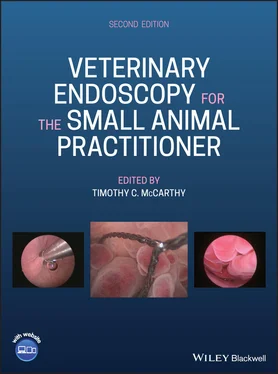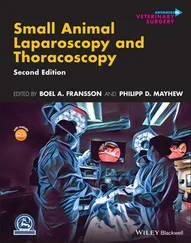Other techniques were slow to develop but have recently expanded to become a major portion of small animal diagnostic and operative procedures. Arthroscopy of the shoulder and stifle joints was reported in the late 1970s and during the 1980s (Siemering 1978, Kivumbi and Bennett 1981; Person 1987; Person 1989) but was very slow to gain acceptance because of its difficulty and the long, steep, frustrating learning curve.
Cystoscopy in male and female dogs was first reported as a research technique in 1930 (Vermooten 1930) but did not appear in clinical use until the 1980s. A technique conceived from the concept of cystocentesis and adapted from human medicine was used in early 1983 for access to the bladder using a prepubic percutaneous approach (McCarthy and McDermaid 1986). This technique initiated endoscopic evaluation of the urinary tract in clinical practice. This publication also initiated identification and study of feline lower urinary tract disease as it relates to interstitial cystitis (Buffington 1994). As an accidental incident, while performing vaginoscopy with the 2.7 mm multipurpose rigid telescope (MPRT), the urethral orifice was identified followed by passage of the telescope through the urethra and into the bladder. From this, transurethral cystoscopy emerged as an easy and effective diagnostic procedure in the 1980s (Biewenga and van Ostrum 1985; Senior and Sundstrom 1988; McCarthy and McDermaid 1990; McCarthy 1996). Availability of small flexible urethroscopes made transurethral cystoscopy in male dogs and cats possible.
Invasion of other natural orifices continued to progress with rhinoscopy, otoscopy, and vaginoscopy being added to the list of procedures available. Invasion of body cavities expanded to include thoracoscopy. All these procedures started as diagnostic techniques allowing examination of the area of interest with ability to collect diagnostic samples.
Expansion of these procedures to include treatment allowing us to correct the pathology that we found provided strong incentive for continued growth of endoscopy in small animal practice. Introduction of minimally invasive surgery in human medicine in the 1980s exploded as the procedure of choice for many abdominal surgeries. This translated rapidly into small animal practice with veterinary involvement including design, development, and testing of instrumentation for minimally invasive surgery plus training human surgeons.
Laparoscopic ovariohysterectomies in small animals first performed as research procedures, identified the possibility of Minimally Invasive Surgery (MIS) in small animals, and was used for technique development. The list of MIS procedures performed in small animal practice has grown to include many of the surgical procedures traditionally done as open surgery. Interventional endoscopy, application of therapeutic corrective procedures with cystoscopy, was developed for correction of ectopic ureters, stone removal, and tumor removal. Laparoscopic‐assisted techniques have also promoted expansion of MIS by applying laparoscopy for access to visualize and exteriorize organs with the use of open surgical technique to perform the actual procedure. This approach allows a minimally invasive approach but without the need for special skills and instrumentation needed for a totally intra‐corporeal procedure. NOTES, natural orifice transluminal endoscopic surgery, is the newest addition to our armamentarium of minimally invasive approaches where surgery is performed with special flexible endoscopes through oral, vaginal, or rectal approaches with no skin incisions.
1 Barringer, B.B. (1947). Cystoscopic examination of female dogs. J. Urol. 57: 185–189.
2 Bernheim, B.M. (1911). Organoscopy; cystoscopy of the abdominal cavity. Ann. Surg. 53: 764–767.
3 Biewenga, W.J. and van Oosterom, R.A.A. (1985). Cystourethroscopy in the dog. Vet. Q. 7: 229–231.
4 Bozzini, P.H. (1806). Lichtleiter, Eine Erfindung zur Anschauung Innere Teile und Krankheiten. J. Prakt. Heilk. 24: 207.
5 Buffington, C.A. (1994). Lower urinary tract disease in cats – new problems, new paradigms. J. Nutr. 124: 2643S–2651S.
6 Dalton, J.F.R. and Hill, F.W.G. (1972). A procedure for the examination of the liver and pancreas in dogs. J. Small Anim. Pract. 13: 527–530.
7 Desormeaux, A.J. (1855). De l'endoscope, instrument propre, a eclairer certaines cavites interieures de l'ecomonie. Comptes Rendus Hebdomadaires De Seances, De l'academie Des Sciences 40: 692.
8 Jacobaeus, H.C. (1910). Ueber Die Moglichkeit Die Zystoskopie Bei Untersuchung Seroser Hohiungen Anzuwenden. Munch. Med. Wochenschr. 57: 2090–2092.
9 Johnson, G.F. et al. (1976). Esophagogastric endoscopy in small animal medicine. Gastrointest. Endosc. 22: 226.
10 Kelling, G. (1902). Ueber Oesophagoskopie, Gastroskopie, und Kolioskopie. Munch. Med. Wochenschr. 49: 21.
11 Killian, G. (1901). Zur Ceschichte der Oesophago‐ Und Gastroskopie. Dtsch. Z. Chir. 58: 499–512.
12 Kivumbi, C.W. and Bennett, D. (1981). Arthroscopy of the canine stifle joint. Vet. Rec. 109: 241–249.
13 Lettow, E. (1972). Laparoscopic examination in liver diseases in dogs. Vet. Med. Rev. 2: 159–167.
14 McCarthy, T.C. (1996). Cystoscopy and biopsy of the feline lower urinary tract. Vet. Clin. North Am. Small Anim. Pract. 1996: 463–482.
15 McCarthy, T.C. and McDermaid, S.L. (1986). Prepubic percutaneous cystoscopy in the dog and cat. J. Am. Anim. Hosp. Assoc. 22: 213–219.
16 McCarthy, T.C. and McDermaid, S.L. (1990). Cystoscopy. Vet. Clin. North Am. Small Anim. Pract. 1990: 1315–1339.
17 Nitze, M. (1879). Beobachtungs und Untersuchungsmethode für Harnrohre Harnblase und Rectum. Wien. Med. Wochenschr. 24: 1651.
18 O'Brien, J.A. (1970). Bronchoscopy in the dog and cat. J. Am. Vet. Med. Assoc. 156: 213–217.
19 Person, M.W. (1987). Prosthetic replacement of the cranial cruciate ligament under arthroscopic guidance. A pilot project. Vet. Surg. 16: 37–43.
20 Person, M.W. (1989). Arthroscopic treatment of osteochondritis dissecans in the canine shoulder. Vet. Surg. 18: 175–189.
21 Senior, D.F. and Sundstrom, D.A. (1988). Cystoscopy in female dogs. Compend. Contin. Educ. Pract. Vet. 10: 890.
22 Siemering, G.H. (1978). Arthroscopy of dogs. J. Am. Vet. Med. Assoc. 172: 575–577.
23 Vermooten, V. (1930). Cystoscopy in male and female dogs. J. Lab. Clin. Med. 15: 650–657.
2 Instrumentation for Endoscopy
Timothy C. McCarthy
Veterinary Minimally Invasive Surgery Training (VetMIST), Beaverton, OR, USA
2.1 Endoscopy Room Setup and Organization
Dedicated endoscopy and operating rooms greatly facilitate performing diagnostic endoscopy and minimally invasive surgery. Having all the equipment setup, organized, and ready to use will have a major impact on the frequency of endoscope use in a busy practice. If getting everything ready is time consuming and difficult, endoscopy will not be performed and everything will get done the old way. Patients will not benefit from the advantages of minimally invasive diagnostic or operative procedures if it is too inconvenient to get the equipment ready. In addition to lack of patient benefit, the practice will also fail to benefit from the purchase of the equipment both from a financial standpoint and improved staff satisfaction in being able to provide better medical care.
This concept also applies to employee training. If the staff is not comfortable with turning on and operating the complex array of equipment required for endoscopy, there will be resistance to use it. With staff resistance to endoscope use, there will be no use and the equipment will be in the way while collecting dust.
If dedicated rooms are not available, specific areas of existing multiuse rooms providing a space for the equipment, adequate room for performing procedures, and suitable environmental conditions to support the needs of the procedures are essential. A room with a large window that cannot be covered does not provide the darkened conditions needed for adequate visibility of video monitors. A room without windows or with small windows that can be covered is a much better choice. A room with high traffic flow is not ideal and an out of the way room with only one entrance is a preferable option. Adequate space is also a must, particularly for an operating room where sterile technique is required. Adding an endoscopy tower to an operating room that is already too small will not provide an optimum surgical environment.
Читать дальше












